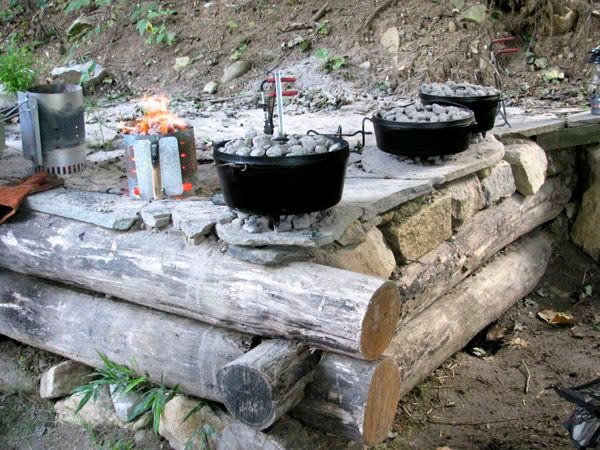Hi, some friends and I want to tackle making a clay-type oven.
A friend and I made an elevated cooking platform out of locust logs for our dutch oven cooking to minimize always having to bend over to check on the food. Here's a photo taken not long after we had built it.

Could I do something like this for a clay oven?
There are some beautiful oven designs on this site but I'd rather not use concrete footers and cement block/bricks for the base if I don't have to.
I tried searching for info but didn't really come across anything for this question.
This thread has an oven similiar to what I'd like to try:
I thought about these types of bases:
A triangular log base.
A base that sits on 4 legs.
A base that is built into the side of a steep hillside with a log base.
A plain old 4-sided log base all made from locust logs.
Was thinking of a 32" to 36" interior dimensions for the oven.
thanks,
Allen
A friend and I made an elevated cooking platform out of locust logs for our dutch oven cooking to minimize always having to bend over to check on the food. Here's a photo taken not long after we had built it.

Could I do something like this for a clay oven?
There are some beautiful oven designs on this site but I'd rather not use concrete footers and cement block/bricks for the base if I don't have to.
I tried searching for info but didn't really come across anything for this question.
This thread has an oven similiar to what I'd like to try:
I thought about these types of bases:
A triangular log base.
A base that sits on 4 legs.
A base that is built into the side of a steep hillside with a log base.
A plain old 4-sided log base all made from locust logs.
Was thinking of a 32" to 36" interior dimensions for the oven.
thanks,
Allen







 , but the basic engineering was the same. Some of them looked like you could just start a fire today, even after being buried by lava dust for generations. Way cool.
, but the basic engineering was the same. Some of them looked like you could just start a fire today, even after being buried by lava dust for generations. Way cool. My avatar is from the pompeii theater. seemed appropriate.
My avatar is from the pompeii theater. seemed appropriate.

Comment